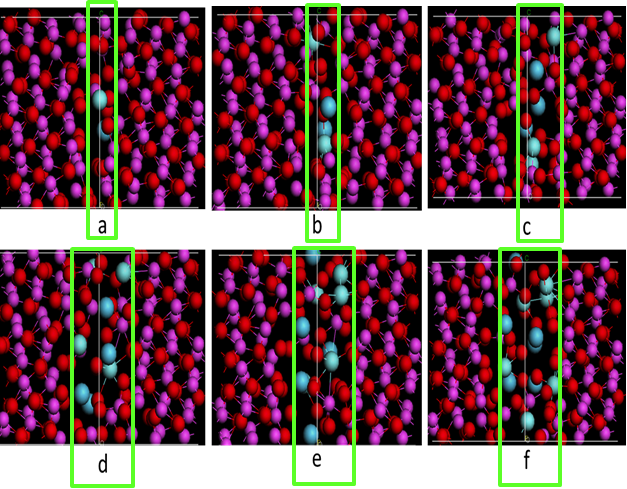As the grain size of sintered ceramics move into the nanosized domain many traditional ceramic materials have shown interesting optical properties. One example is alumina which is known to become transparent if the grain size gets sufficiently small and porosity is low. Control of the grain size is often established by the use of dopants (e.g. Y, Mg, La) and high pressure sintering techniques. However, the exact mechanisms behind the effect of the dopants is not entirely understood. It is known that these dopants often segregate to grain boundaries. Additionally the dopants may also have an influence on the diffusive properties in the material. Consequently these two aspects of doping, grain boundary segregation (for both single and co-doped aluminas) and diffusion, are being studied by atomistic scale simulations to increase our understanding of its influence on sintering and the final properties of the material.
 |
|
| (11.1) Y-La codoped GB with increasing dopant concentration – complex transition I to II – b → c with grain boundary concentration increasing from 4-6 atom/nm2 |
- Grain Boundary Segregation of Single Dopants (Y, La, Mg) – (link to more details)
- Grain Boundary Segregation in Alumina – Codoping – (link to more details)
- Oxygen Diffusion in Alumina – (link to more details)
Publications
[1] Galmarini S., Aschauer U., Bowen P., Parker S.C., Atomistic Simulation of Y-Doped α-Alumina Interfaces, Journal of the American Ceramic Society, 91(11), (2008), 3643-51, (Link to article)
[2] Galmarini S., Aschauer U., Tewari A., Aman Y., Van Gestel C., Bowen P., Atomistic modeling of dopant segregation in α-alumina ceramics: Coverage dependent energy of segregation and nominal dopant solubility. Journal of the European Ceramic Society (2011),31:2839–52 (Link to article)
[3] Tewari A., Galmarini S., Stuer M., Bowen P., Atomistic modeling of the effect of codoping on the atomistic structure of interfaces in α-alumina. Journal of the European Ceramic Society (2012),32:2935–48 (Link to article)
[4] A. Tewari, F. Nabiei, S. C. Parker, M. Cantoni, M. Stuer, P. Bowen, C. Hébert Towards Knowledge Based Grain Boundary Engineering of Transparent Polycrystalline Alumina Combining Advanced TEM and Atomistic Modeling” J. Am. Ceram. Soc., in press (2015) DOI: 10.1111/jace.13552
[5] Aschauer U., Bowen P., Parker S.C., Oxygen vacancy diffusion in alumina: New atomistic simulation methods applied to an old problem, Acta Materialia, 57(16), (2009), 4765-72, (Link to article)
[6] A. Tewari, U. Aschauer, P. Bowen, “Atomistic Modeling of Effect of Mg on Oxygen Vacancy Diffusion in [alpha]-Alumina” J.Amer.Ceram.Soc., 97(8) 2596-2601 (2014)